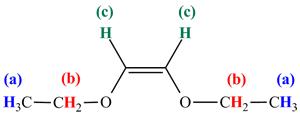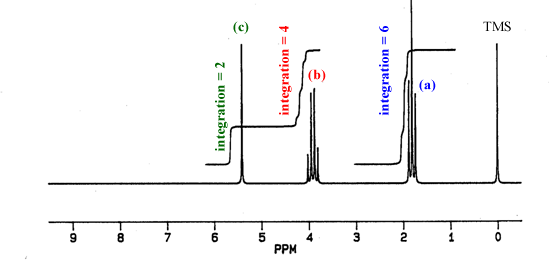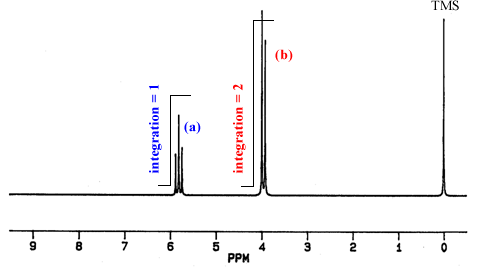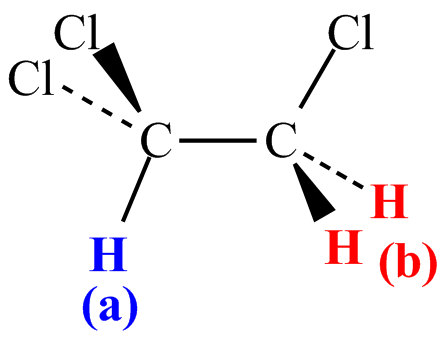| |

|
Introduction to Structure Determination |
|
| NMR: The Spectrum |
|
|
|
|
|
|
A NMR spectrum contains lots of information about the functional groups and connectivity in a molecule. Whether you are predicting what the NMR spectrum of a compound will look like or trying to determine the structure of a compound from its NMR spectrum, a number of steps must be followed:
-
Use the chemical shifts and charateristic chemical shift tables (1H NMR, 13C NMR) to determine the functional groups present.
-
Use the number of chemical shifts and the chemical formula (if available) to work out the number of equivalent nuclei and hence the presence or absence of symmetry in the molecule. For example, if there are 4 C atoms in the formula but only 2 chemical shifts in the 13C NMR spectrum then the molecule must possess symmetry which makes some of the nuclei equivalent.
-
In 1H NMR spectrum, use the integration to determine the number of 1H nuclei in each chemical environment.
-
In the 1H NMR spectrum, use the number of lines in to which each signal is split through coupling and the 'n + 1' rule to determine the number of neighbouring atoms and hence work out which groups are connected (and which are not).
-
If 1H and 13C NMR spectra are both available, make sure that your analysis is consistent.
Example 1: Predicting the Spectrum from a Structure
|
The process of predicting the spectra from a known structure is best illustrated with an example. The 1H NMR of the molecule oppsite is shown below. It can be rationalized using the steps outlined above:
|
-
Using the 1H NMR chemical shift table, the 1H chemical shifts are predicted to be:
(a) CH3 bonded to C: chemical shift 0.8 - 1.2 ppm (observed at 1.21 ppm).
(b) CH2 bonded to O: chemical shift 3.2 - 5.4 ppm (observed at 4.49 ppm).
(c) H bonded to C=C: chemical shift 4.9 - 5.9 ppm (observed at 5.26 ppm).
- There is a mirror plane that cuts through the C=C bond. There are 3 chemical environments, (a), (b) and (c), and so 3 signals in the spectrum.
|
|
 |
|
- There 2 × 3 = 6 1H in group (a). The signal at 1.21 ppm integrates to 6.
There 2 × 2 = 4 1H in group (b). The signal at 4.49 ppm integrates to 4
There 2 × 1 = 2 1H in group (c). The signal at 5.26 integrates to 2.
- (a) The 1H nuclei in set (a) are next to the 2H in set (b). There are 2 neighbours so n = 2 and n + 1 = 3. The signal due to set (a) at 1.21 ppm is split into a 1 : 2 : 1 triplet.
(b) The 1H nuclei in set (b) are next to the 3H in set(a). There are 3 neighbours so n = 3 and n + 1 = 4. The signal due to set (b) at 4.49 ppm is split into a 1 : 3 : 3 : 1 quartet.
(c) The 1H nuclei in set (c) do not have any H on neighbouring atoms. (Remember that no coupling is observed between equivalent nuclei: the 2 H atoms are equivalent.) There are 0 neighbours so n = 0 and n + 1 = 1. The signal due to set (c) at 5.26 ppm is a singlet.
|
|
 |
|
Example 2: Predicting the Structure from a Spectrum
|
The process of predicting the structure from a NMR spectrum can also be best illustrated with an example. The 1H NMR of one of isomers of trichlorethane, C2H3Cl3 is shown below. The structure of the isomer can be deduced using the steps outlined above:
|
-
Using the 1H NMR chemical shift table, the chemical shifts corresponding to (a) and (b) are both too high to be for a 1H nucleus attached to an alkyl group. All 3 1H nuclei must be bonded to a C atom which is itself bonded to at least 1 Cl atom. This rules out CH3CCl3. The chemical shift for (b) is consistent with a 1H nucleus bonded to a -CClR2 group. The chemical shift for (a) is higher and this is consistent with it being due to a 1H nucleus bonded to a -CCl2R group, with the higher shift due to the additional electronegative Cl group.
- There are 3 H in the chemical formula but only 2 peaks in the spectrum. 2 of the 1H nuclei must be equivalent.
- This is also consistent with the integration which shows that peak (a) is due to 1 H and peak (b) is due to 2 equivalent H. Signal (a) corresponds to a CH group and (b) corresponds to a CH2 group.
-
The 1H giving rise to (a) couples to the 2 H in set (b). With 2 neighbours, n = 2 and n + 1 = 3. The signal due to (a) is split into a 1 : 2 : 1 triplet.
The 2 1H giving rise to (b) couples to the 1 H in set (a). With 1 neighbour, n = 1 and n + 1 = 2. The signal due to (b) is split into a 1 : 1 doublet.
All of the information is consistent with the structure opposite: 1,1,2-trichloroethane.
|
|

 |
| |
|
| |
|
 |
| |
| |




